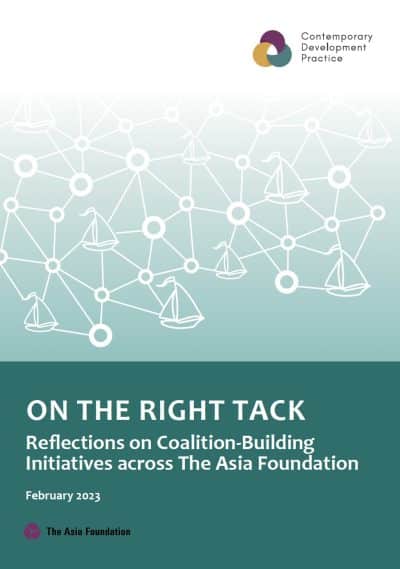




Guest post by Nicola Nixon, Erman Rahman, Sumaya Saluja and Rahpriyanto Alam Surya Putra
‘Coalition-building’: one of those topics that gets enthusiastic nods of approval among development practitioners. But what distinguishes effective from ineffective coalitions and what can donors do to support them?’
In The Asia Foundation’s recent reflection paper On the right tack: reflections on coalition-building in The Asia Foundation, we look at several case studies, some of which involve goals achieved by coalitions of individuals and organizations collaborating over decades. In each case, the Foundation initiated coalition-building efforts to facilitate locally-led and sustainable change, which are achieved by fostering relationships between powerful actors while amplifying the voices and influence of those less powerful.
Take, for example, the work of our Indonesia office on supporting improved local governance.

Since 2001, the Indonesian government has been pursuing an ambitious policy of fiscal, administrative and political decentralization. Indonesia’s decentralization agenda seeks to foster bottom-up development by providing subnational governments with larger budgets and greater discretion over how to use them in ways that ideally serve the interests of communities and in are line with regional development goals. Yet, subnational governments have struggled to implement the agenda to its maximum benefit.
In 2004, The Asia Foundation’s Indonesia office began using a coalition-building approach to supporting local governments in strengthening the quality, effectiveness and inclusiveness of the latter’s planning and budgeting. Coalitions were two-tiered, comprised of a handful of national civil society organizations (CSOs) with technical skills in research and budget analysis, which were well-positioned to mentor a larger number of small, local, advocacy-based CSOs. For example, under one governance program, the Foundation convened approximately 30 organizations that were advocating for more resources and greater transparency in budgets for basic services such as health and education. Most local CSOs had limited research experience or skills in evidence-based advocacy. Over several years, through collaboration and mentoring, members of the coalition improved their ability to collect and analyze government data and to advocate effectively for local policy reforms. For example, by 2010 coalitions of local stakeholders in the cities of Pekalongan and Semarang in Central Java had succeeded in influencing the respective municipal governments to increase spending on local health insurance.

As work progressed and these kinds of city- and district-level reforms were being achieved, the Foundation and its partners sought to encourage improvements in national fiscal decentralization policy. In collaboration with Seknas FITRA – an organization focused on government budget transparency – local CSOs across 42 districts advocated successfully for several new national policies that promoted higher spending on education and health services, as well as measures to reduce pork barreling in local spending.
In 2010, the Foundation expanded the national-level coalition to increase its reach and impact. Convened by Pattiro – an organization that pursues governance reform – the coalition included Seknas FITRA and nine local organizations. Learning from the previous program, Seknas FITRA supported local CSOs to advocate for more gender-responsive policies. Pattiro used the information gathered at the local level to lead the coalition in advocating for the adoption of a national strategy for gender-responsive budgeting.

In 2012, the Foundation teamed up again with Pattiro, Seknas FITRA, and the Indonesia Budget Center (IBC) to explore how fiscal decentralization could support better environmental policies. The three organizations convened 34 local CSOs and several local government officials around analyses of natural resource-related revenues and environmental protection policies. The Civil Society Coalition for Environmental Protection Financing discovered that, on one hand, competing priorities led subnational governments to rarely prioritize environmental protection, while on the other hand, several sources of state funding for environmental protection were underutilized due to unrealistic regulatory requirements.
To encourage environmental protection, the coalition successfully developed and advocated for the government to take up an ecological fiscal transfer (EFT) instruments. The EFT incentivized lower-level governments to increase their budget allocation if they could demonstrate improved environmental management. To date, 22 subnational governments have adopted EFT schemes. To address the issue of unspent budgets, the coalition successfully advocated the Ministry of Finance to produce a new regulation in 2018 that allows a pre-existing but underutilized “Reforestation Fund” to finance more proactive environmental protection activities such as social forestry, in addition to the conventional tree planting.
Over almost 20 years, these coalition-driven efforts to improve local government planning and budgeting – for better basic services, gender-responsive policies, and improved environmental management – have been financed by a range of donors, including the Australian, United Kingdom, United States, Canadian and Netherlands governments. Each investment involved a three-to-five-year project, focused on the delivery of outcomes such as improved guidelines, capacities and policy changes. When projects are time-bound, their results and outcomes invariably tend to be measured within the narrow frame of the project cycle—akin to focusing on individual trees without glimpsing the forest as a whole. The forest reveals itself over time, in the subtle, long-term evolution of the trust-based relationships in which the progress of coalition efforts must be grounded to be sustainable. In stepping back, and ideally staying the course through successive investments, we can see the forest.
Coalition building is both long-term and labor intensive. It requires careful attention to shifting stakeholder preferences, strategies, goals, and allegiances. As with other case studies presented inthe aforementioned paper, including policy reform in the Philippines and subnational governance reforms in Nepal and Sri Lanka, coalition members understand that change – whether it involves formal institutions or informal norms and values – requires adaptability and the careful navigation of local political economies.
To support this kind of work, donors need to think in decades. As with the Indonesia example featured here, a coalition’s most transformational successes are often realized on the second or even third project cycle. Integral to these achievements are the long-term relationships that are deepened through years of shared success, failure and learning. When people, relationships and working partnerships take center stage, a coalition-building modality moves beyond the more formulaic and technocratic modalities such as capacity development, knowledge transfer, and technical assistance, to valuing desired longer-term results such as greater solidarity, stronger and more effective networks and improved collective action. In this way, sustained cooperation gains primacy over short-term outputs and deliverables, and the forest thrives.